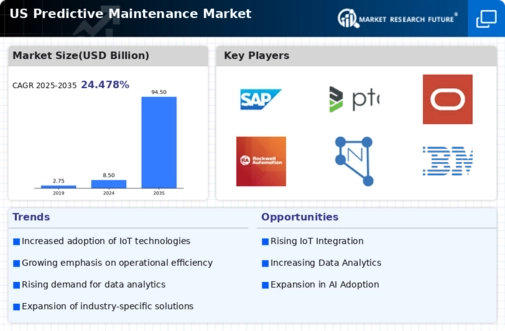The predictive maintenance market is currently characterized by a dynamic competitive landscape, driven by technological advancements and an increasing emphasis on operational efficiency. Key players such as IBM (US), General Electric (US), and Honeywell (US) are at the forefront, leveraging their extensive expertise in data analytics and IoT to enhance predictive capabilities. IBM (US) focuses on integrating AI and machine learning into its solutions, aiming to provide clients with actionable insights that can preempt equipment failures. General Electric (US), on the other hand, emphasizes its digital twin technology, which simulates real-world conditions to optimize maintenance schedules. Honeywell (US) is strategically positioning itself through partnerships with various industrial firms, enhancing its service offerings and expanding its market reach. Collectively, these strategies foster a competitive environment that prioritizes innovation and customer-centric solutions.
In terms of business tactics, companies are increasingly localizing manufacturing and optimizing supply chains to enhance responsiveness and reduce costs. The market structure appears moderately fragmented, with several players vying for market share while also collaborating through strategic partnerships. This collective influence of key players not only intensifies competition but also drives the adoption of advanced technologies across various sectors.
In October 2025, IBM (US) announced a significant partnership with a leading automotive manufacturer to implement its AI-driven predictive maintenance solutions. This collaboration is expected to enhance the manufacturer's operational efficiency by reducing downtime and maintenance costs, thereby underscoring IBM's commitment to innovation in predictive analytics. The strategic importance of this partnership lies in its potential to set a benchmark for AI integration in the automotive sector, which is increasingly reliant on data-driven decision-making.
In September 2025, General Electric (US) launched a new version of its Predix platform, which incorporates enhanced machine learning algorithms for predictive maintenance. This upgrade aims to provide users with more accurate forecasts of equipment failures, thereby improving maintenance planning and resource allocation. The strategic significance of this development is profound, as it positions General Electric (US) as a leader in the digital transformation of industrial maintenance, potentially reshaping industry standards.
In August 2025, Honeywell (US) expanded its predictive maintenance offerings through the acquisition of a software startup specializing in IoT solutions. This acquisition is likely to bolster Honeywell's capabilities in real-time data analytics, enabling more precise predictive maintenance strategies. The strategic importance of this move lies in its alignment with the growing trend of integrating IoT technologies into maintenance practices, which could enhance Honeywell's competitive edge in the market.
As of November 2025, current trends in the predictive maintenance market are heavily influenced by digitalization, sustainability, and the integration of AI technologies. Strategic alliances are increasingly shaping the competitive landscape, allowing companies to pool resources and expertise to drive innovation. Looking ahead, it appears that competitive differentiation will evolve from traditional price-based competition to a focus on technological innovation, reliability in supply chains, and the ability to deliver tailored solutions that meet the specific needs of clients.
























Leave a Comment